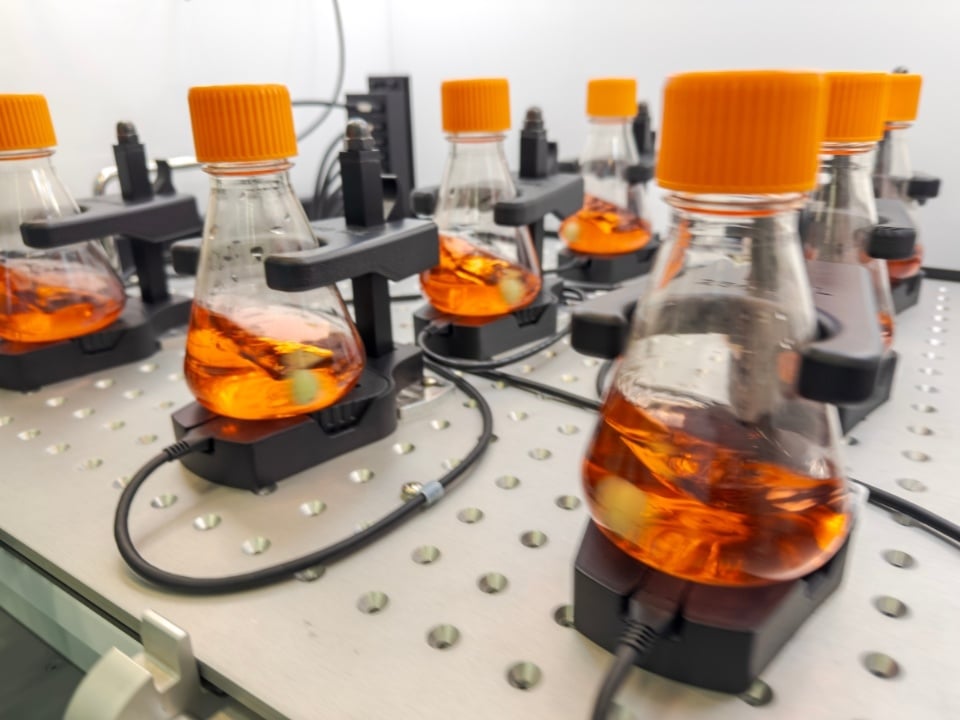Human Embryonic Kidney (HEK) Cells: A Game-changer in Biotechnology

Human Embryonic Kidney (HEK) cells have played a transformative role in biotechnology, drug development, and gene therapy for decades. Since their development in the 1970s, these cells have become one of the most widely used mammalian cell lines, serving as a foundation for protein production, viral vector manufacturing, and vaccine development.
What makes HEK cells so valuable? How do they compare to other cell lines? And what innovations are shaping their future? In this post, we'll provide a comprehensive overview of HEK cells and their significance in biopharma.
A brief history: where did HEK cells come from?
Development of the HEK293 cell line began in 1973 at Leiden University under the direction of Dutch scientist Alex van der Eb and colleague Frank Graham. They transfected human embryonic kidney tissue cells, which they obtained using adenovirus 5 DNA. This mechanism resulted in the steady integration of viral genes into the genome, enabling the cells to grow fast in the lab and virtually immortality. Scientists have created various variants of HEK cells over the years, each tailored for a particular use:
| HEK Cell Line | Key Feature | Primary Applications |
| HEK 293 | Original adherent cell line |
Protein expression, transfection studies |
| HEK 293T | Expresses SV40 large T antigen | High-efficiency transient transfection |
| HEK 293F | Adapted for suspension culture |
Bioreactor-based protein production |
| HEK 293SF | Grown in serum-free conditions | Bioprocessing with reduced contamination risk |
| HEK 293 FT | High transfection efficiency | Gene expression and viral production |
Why are HEK cells so popular?
Unlike bacterial or yeast systems, HEK cells are like human cells, making them perfect for manufacturing proteins and biologics that fit the human system. The following explains their great popularity:
- Human-like protein mechanism
Crucially for the correct operation of therapeutic proteins, post-translational modifications (PTMs), including glycosylation, phosphorylation, and folding, are where HEK cells shine. - Strong transfection
Extremely easy to transfect, HEK cells can quickly absorb foreign DNA and express proteins. This makes them perfect for: production of recombinant proteins, production of gene therapy vectors, and studies on Crisper/Cas9 gene editing - Flexibility in manufacturing management
HEK cells enable several bioprocessing uses:
✓ Antibody and enzyme synthesis
✓ Vaccine development (certain COVID-19 vaccines were generated with HEK cells)
✓ Viral Vector Production for Gene Therapy - Flexibility for suspension culture
Although early HEK cells were adherent, newer HEK lines (HEK293F, HEK293SF) have been modified for suspension culture, hence enabling scalable manufacture in bioreactors. - Industry trust and regulatory approval
FDA- and EMA-approved biologics including HEK cells have good regulatory precedent for therapeutic manufacturing.
Challenges of HEK cell culture
HEK cells are not ideal despite their several benefits. These are a few typical difficulties:
- Reducing protein yield HEK cells are less efficient for mass monoclonal antibody manufacture than CHO (Chinese Hamster Ovary) cells since they generate less protein.
- Genetic instability: HEK cells can occasionally demonstrate varying gene expression across several cell batches since they include integrated viral DNA. Innovations and the future of HEK cells.
- HEK cells are more effective for bioproduction since Crispen is being utilized to enhance gene stability and optimize metabolic pathways, therefore improving the efficiency of the cells.
- Al and Machine Learning in Bioprocessing: By now Al-powered platforms can forecast and maximize HEK cell culture parameters, hence enhancing batch consistency and scalability.
- Researchers are reprogramming HEK cells in synthetic biology and cell line engineering to increase viral vector generation, boost protein release, and modify glycosylation patterns.
- Advanced analytics enables researchers to better understand HEK cell metabolism, hence guiding wiser culture conditions and improved yield management from multi-omics analysis (genomics, proteomics, metabolomics).
What's next for HEK cells in biopharma?
HEK cells will likely continue evolving to meet the growing demands of biomanufacturing and gene therapy. Some exciting future directions include:
- More efficient gene therapy production
- HEK cells will remain the gold standard for AAV, lentiviral, and adenoviral vector production, which are essential for gene therapy and personalized medicine.
- Next generation biologics
- With ongoing engineering efforts, HEK cells may compete with CHO cells in monoclonal antibody production.
- Automated biomanufacturing
- Al-driven bioprocess control could make HEK-based biologics cheaper, faster, and more scalable.
- Personalized medicine applications
- HEK cells could be used to test patient-specific drug responses, accelerating precision medicine development.
- HEK cells could be used to test patient-specific drug responses, accelerating precision medicine development.
Conclusion
For decades, HEK cells have led the way in biopharmaceutical developments from gene therapy to vaccine creation. Scientists and businesses both benefit much from their human-like protein synthesis, flexibility, and transfection efficiency. HEK cells will probably become increasingly more important as bioprocessing technologies develop in determining the future generation of biologics, regenerative medicine, and individualized treatments.